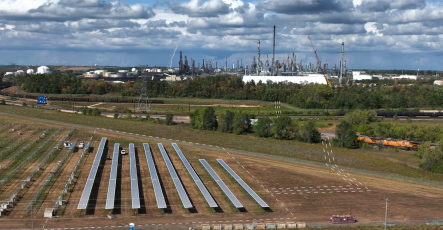Behind government “moonshots” and corporate sustainability pledges lie multitudes of technological innovations required to make these aspirations possible. The fuel and petrochemical industries play critical roles in advancing and scaling the new technologies that will help us address the dual challenge of providing the products the world needs to thrive while operating in an increasingly sustainable way. And AFPM members are taking their responsibilities seriously, working independently and with outside stakeholders – including the U.S. government -- to provide the innovations needed to address this dual challenge. Following are some examples of industry-government partnerships working to improve the sustainability of the fuels and feedstocks that will continue to power America’s economy for decades to come.
Air Products and Chemicals, Inc. partners with DOE and Valero to create “first of its kind” system to capture carbon from hydrogen production process
While hydrogen is often the beneficial byproduct of other chemical processes, the intentional production of hydrogen using steam methane reformers (SMR) produces its own, less desirable, byproduct: carbon dioxide.
Working in partnership with Valero and the U.S. Department of Energy, Air Products and Chemicals developed the first commercial-scale retrofit system to capture the carbon dioxide byproduct created during the production of hydrogen at Valero’s Port Arthur Refinery.
The project – funded in part by a $284 million investment from the Department of Energy and co-managed by the National Energy Technology Laboratory (NETL) and Air Products – captures 50 million cubic feet of carbon dioxide per day from the SMR process and compresses it to a “greater than 97 percent purity.” Then the CO2 is shipped via pipeline to older oil reservoirs where it is used in CO2-enhanced oil recovery (CO2-EOR) operations, displacing oil residue trapped in rock pores and forcing it into nearby well bores before being permanently trapped underground.
“CO2-EOR,” the DOE wrote, “allows CO2 to be stored safely and permanently in geologic formations, while increasing oil production from fields once thought to be exhausted.”
This large-scale project is capturing about one million tons of carbon dioxide per year from the Port Arthur refinery’s state-of-the-art hydrogen production facility and forging a successful new path for hydrogen production technology.
“This groundbreaking project demonstrates the potential to produce economic benefits and increase our energy security while greatly reducing the environmental impacts of our fossil energy use,” Christopher Smith, acting assistant secretary for Fossil Energy, said.
ExxonMobil invests $100 million in DOE labs to research biofuels, carbon capture, and wind turbine lubricants
ExxonMobil pledged in 2019 to invest up to $100 million over 10 years to research and develop advanced lower-emissions technologies with two U.S. Department of Energy labs – the National Renewable Energy Laboratory and National Energy Technology Laboratory.
This commitment, one of the largest to date between the private sector and DOE’s laboratories, will support industry-government research and collaboration into ways “to bring biofuels and carbon capture and storage to commercial scale across the transportation, power generation and industrial sectors.”
The partnership will focus on developing technologies to improve energy efficiency, mitigate greenhouse gases and reduce emissions from fuel and petrochemical production. The agreement will also “facilitate work with other national laboratories, such as the Idaho National Lab,” according to the DOE.
“We’re focusing on advancing fundamental science to develop breakthrough solutions that can make a difference on a global basis in emissions reduction,” said Darren W. Woods, chairman and CEO of ExxonMobil. “We’re doing that with our in-house scientists and with corporate partners, through relationships with 80 universities and now with the intellectual and computing capacity of the renowned national labs.”
For example, ExxonMobil recently partnered with ten of Houston's largest energy and chemical companies – including Chevron, Dow, INEOS, Linde, LyondellBasell, Marathon Petroleum, Phillips 66 and Valero – to develop plans to create a large-scale carbon capture and storage (CCS) complex in the Houston area that could lead to capturing and safely storing up to 50 million metric tons of CO2 per year by 2030 and about 100 million metric tons by 2040.
“Houston can achieve our net zero goals by working together, and it’s exciting to see so many companies have already come together to talk about making Houston the world leader in carbon capture and storage,” said Sylvester Turner, Mayor of Houston.
ExxonMobil is also moving forward their vision via a partnership with the Argonne National Laboratory, which recently created a new class of nanotechnology-based lubricant that forms protective layers that are thicker and more robust than current lubricants – and which could enhance the performance and reliability of wind turbines. Argonne will work with Exxon Mobil to “optimize this new lubricant for drivetrain applications” and execute full-scale drivetrain testing and field trials.
DOE grant helps Phillips 66 advance fuel cell technology
The Department of Energy awarded Phillips 66 $3 million grant this year to advance the development of high-performance reversible solid oxide fuel cells (SOFC). The company announced it would partner with Georgia Tech on the project “to demonstrate the commercial feasibility of a low-cost and highly efficient RSOFC system for hydrogen and electricity generation.”
Phillips 66 is a leader in solid oxide fuel cell technology, holding eight U.S. patents in its SOFC intellectual property portfolio, with 22 additional patents pending. And this technology is just one of many the company is pursuing as part of its commitment to a sustainable, lower-carbon energy future.
CEO Greg Garland expects the use of electric vehicles to continue to grow globally. Phillips 66, he said, can make “nice contributions there in terms of what we bring to batteries and battery technology.”
Speaking on the fourth quarter earnings call earlier this year, Garland said the challenge of providing “reliable, affordable abundant energy” while simultaneously addressing the climate requires a holistic approach by “people that understand the complexity of the energy business today. … I think they’re some of the best people on the planet that are positioned to help solve this dual challenge that we have,” he said. “I think this industry, and our company certainly, will have a big role to play in the energy transition as we move forward.”
While he acknowledged that the refining industry is likely to be smaller in the future, the demand for plastics and other petroleum-made inputs for everything from batteries and electric vehicles to solar panels is set to continue to grow and offer opportunities for crude processors like Phillips 66. As he succinctly put it: “You can’t build a Tesla without fossil fuels.”
And you can’t have a successful energy transition without the fuel and petrochemical industries.
According to the IEA’s May 2021 report, Net Zero by 2050: A Roadmap for the Global Energy Sector, “Reaching net zero by 2050 requires further rapid deployment of available technologies as well as widespread use of technologies that are not on the market yet. … The biggest innovation opportunities concern advanced batteries, hydrogen electrolysers, and direct air capture and storage [CCUS]. Together, these three technology areas make vital contributions to the reductions in CO2 emissions between 2030 and 2050 in our pathway. … The expertise of the oil and natural gas industry fits well with technologies that are needed to tackle emissions in sectors where reductions are likely to be most challenging. … Without the oil and gas industry, the transformation of the energy sector will be more difficult and more expensive.”


